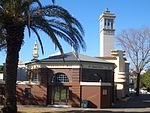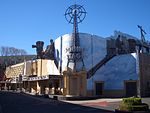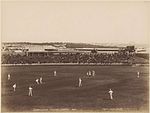The Sydney Riot of 1879 was an instance of civil disorder that occurred at an early international cricket match. It took place on 8 February 1879 at what is now the Sydney Cricket Ground (at the time known as the Association Ground), during a match between New South Wales, captained by Dave Gregory, and a touring English team, captained by Lord Harris.
The riot was sparked by a controversial umpiring decision, when star Australian batsman Billy Murdoch was given out by George Coulthard, a Victorian employed by the Englishmen. The dismissal caused an uproar among the spectators, many of whom surged onto the pitch and assaulted Coulthard and some English players. It was alleged that illegal gamblers in the New South Wales pavilion, who had bet heavily on the home side, encouraged the riot because the tourists were in a dominant position and looked set to win. Another theory given to explain the anger was that of intercolonial rivalry, that the New South Wales crowd objected to what they perceived to be a slight from a Victorian umpire.
The pitch invasion occurred while Gregory halted the match by not sending out a replacement for Murdoch. The New South Wales skipper called on Lord Harris to remove umpire Coulthard, whom he considered to be inept or biased, but his English counterpart declined. The other umpire, future prime minister Edmund Barton, defended Coulthard and Lord Harris, saying that the decision against Murdoch was correct and that the English had conducted themselves appropriately. Eventually, Gregory agreed to resume the match without the removal of Coulthard. However, the crowd continued to disrupt proceedings, and play was abandoned for the day. Upon resumption after the Sunday rest day, Lord Harris's men won convincingly by an innings.
In the immediate aftermath of the riot, the England team cancelled the remaining games they were scheduled to play in Sydney. The incident also caused much press comment in England and Australia. In Australia, the newspapers were united in condemning the unrest, viewing the chaos as a national humiliation and a public relations disaster. An open letter by Lord Harris about the incident was later published in English newspapers, and caused fresh outrage in New South Wales when it was reprinted by the Australian newspapers. A defensive letter written in response by the New South Wales Cricket Association further damaged relations. The affair led to a breakdown of goodwill that threatened the future of Anglo-Australian cricket relations. However, friction between the cricketing authorities finally eased when Lord Harris agreed to lead an England representative side at The Oval in London against the touring Australians in 1880; this match became the fourth-ever Test and cemented the tradition of Anglo-Australian Test matches.










